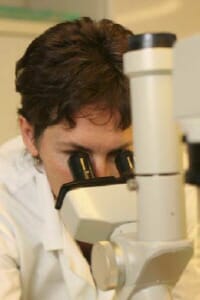The product was effective and profitable for both the producer and Intervet. AQUAVAC-ESC had to be freeze-dried to protect the live bacteria that made it effective. But the freeze-drying process took more than a week. While that was acceptable in 2000, by 2005, Intervet had developed many new products that also needed the same equipment. We just couldnt tie up the dryers that long and a decision was taken to stop production, unless someone could find a way to produce and deliver AQUAVAC-ESC in another form.
 |
| Outside the Box Intervet USA team |
 |
| Kurt Schuster-Mr Motivator |
 |
| Outstanding in their field Intervet USA team |
On July 20, 2005 Intervet vice-president Steve Ellsworth sent out a memo: All right folks, its up to us to save this product. With production of AQUAVAC-ESC all but halted, there was no way to tide over farmers for a year while a new product could be developed. Missing a year was not an option, neither was asking the farmers to wait. Its a two-month vaccination season. Its May and June and its over. If we were going to stay in aquaculture, we had to have a product, said Kurt Schuster, Business Manager, Aquaculture (Millsboro, Delaware). Steve Ellsworth gathered a team from Millsboro and De Soto (Kansas); Kurt Schuster became the motivator. The new form of AQUAVAC-ESC had to be developed, tested, packaged and marketed within 8 months! The team knew from the original licence process that the product could be frozen and that both the historical data and stability data could be used. But freezing the vaccine proved to be straight forward. Then they tried to store the frozen vaccine. We thought wed be able to store it at -20 C but the product began to lose titer after a week at -20 C, and became ineffective soon after that. We needed to store it at -70 C. It was a big problem because most customers werent equipped with so-called super-cool freezers. If customers couldnt store it, they wouldnt buy it. Some thought the AQUAVAC-ESC experiment was over.
Kurt Schuster thought differently. Farm-raised catfish come primarily from Mississippi, and almost all of the aquaculture industry is located in six counties in the western part of the state. If Intervet could store the vaccine at -70 C in the heart of catfish country, and deliver the product to customers once a week, the frozen version of AQUAVAC-ESC might have a chance. Customers could store it for one week at -20 C degrees. But we had to get the data to support that we could store it at -20 C for seven days, said Schuster. Tests were run using different packaging materials, different amounts of dry ice, hot and humid conditions, and storage at -20 C, said Rob Vanaman, Warehouse Clerk IV (Millsboro, Delaware). Intervet would adequately be able to get the product to the customer at the temperature required, and provide storage at a minimal cost. That meant middle-of-the-night shifts to fill, label, pack and freeze the product for delivery. Time constraints added stress to the project but there were also successes. Freezing the vaccine resulted in more doses per vial than freeze-drying. The new version of AQUAVAC-ESC also appeared to be more effective than the original, based on preliminary tests.
And so, against the odds, the first license on the new AQUAVAC-ESC came in March 2006, with little time to spare. Sometimes big improvements can be had with minimal changes, especially when you think outside the box, said Wayne Katt, Bacterin Senior Production Supervisor (De sota, Kansas), when asked about lessons learned from this AQUAVAC-ESC challenge. Yugang Luo, R&D Group Leader (Millsboro, Delaware) puts it even more succinctly: Have some plan Bs. It also clearly reflects Intervets Together We Can company-wide mission. Everyone came together, we had a goal, we had a timeline and we knew we had to get it done. You say, yeah we have a problem, but if we all think together, we can fix this.


